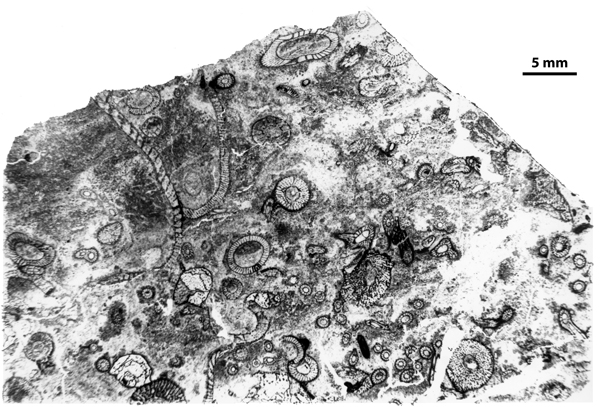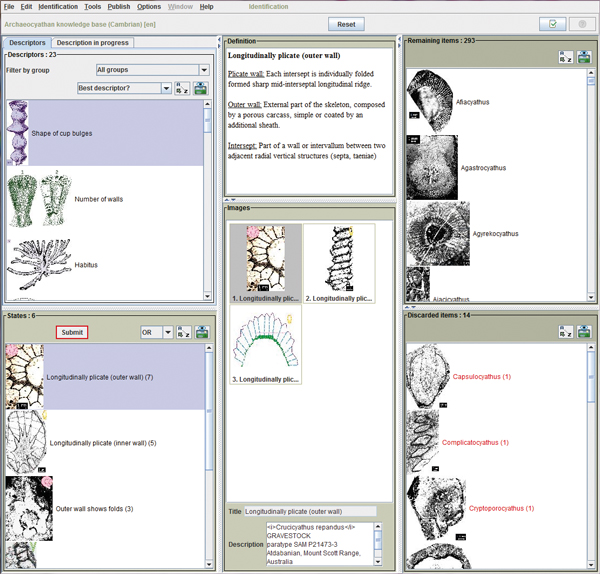[Introduction]
[Role of archaeocyaths ...] [A usable database
...]
[Conclusions] and ...
[Bibliographic references]
CNRS (UMR 7207, centre de recherche sur la paléobiodiversité et les paléoenvironnements), Laboratoire Informatique et Systématique, MNHN Département Histoire de la Terre, Bâtiment de Géologie, CP48, 57 rue Cuvier, 75005 Paris (France)
UPMC, université Pierre et Marie Curie, (UMR 7207, centre de recherche sur la paléobiodiversité et les paléoenvironnements),
Laboratoire Informatique et Systématique, MNHN Département Histoire de la Terre, Bâtiment de Géologie, CP48, 57 rue Cuvier, 75005 Paris (France)
13 rue du long foin, 91700 Sainte Geneviève des bois (France)
Manuscrit en ligne depuis le 5 Juillet 2011
The Archaeocyatha are a key group in several of the many discrete disciplines that together make feasible a valid history of the Earth: they are the oldest of the calcified sponges, the first metazoans to build reefs (in association with calcimicrobes), are characteristic fossils used for the biozonation of the first, pre-trilobitic Cambrian stage (Tommotian)… To date, a valid key to their identification has not been available, so a tool for that purpose has been devised: it was created using the software XPER2, and is now available free, online. Published in English, the knowledge base includes the 307 valid described genera identified by 120 descriptors (85 morphological and ontogenetic, 8 stratigraphic and geographic and 27 taxonomic). A key to identification is supplemented by detailed descriptive cards with images of type specimens of each genus and details of their morphology that aid identification.
Archaeocyatha; Cambrian; free access key; knowledge base; XPER2.
A., R. & F. (2011).- Computer-aided identification of the Archaeocyatha genera now available online.- Carnets de Géologie / Notebooks on Geology, Brest, Letter 2011/02 (CG2011_L02), p. 99-102.
Base d'identification assistée par ordinateur des genres d'archéocyathes disponible en ligne.- Les archéocyathes sont un groupe-clé dans différents domaines de l'histoire de la Vie et de la Terre: ils représentent les plus anciennes éponges à squelette calcifié, ils sont les premiers métazoaires constructeurs de récifs, en consortium avec des calcimicrobes, ils ont été les fossiles caractéristiques des biozonations du premier étage pré-trilobitique du Cambrien, le Tommotien… Pour faciliter l'accès à leur identification il a paru nécessaire de proposer l'outil qui manquait jusqu'à présent. Une base de connaissances en anglais, réalisée à l'aide du logiciel XPER2 est aujourd'hui mise en ligne gratuitement. Elle comprend les 307 genres considérés actuellement valides et contient un module d'identification utilisant 120 descripteurs (85 morphologiques et ontogénétiques, 8 stratigraphiques et géographiques et 27 taxonomiques) et des fiches descriptives détaillées avec les photos des spécimens-types pour chaque genre.
Archéocyathes ; Cambrien ; clé à accès libre ; base de connaissance ; XPER2.
Archaeocyaths are found only in strata of Cambrian age. They were the first metazoans to build organic bioconstructions on their own. Their biologic and stratigraphic placement is now consensual: archaeocyaths are an extinct class (Cambrian only) of the phylum Porifera, close to the living Demospongiae ( & , 1984).

Cliquer sur la miniature pour agrandir l'image.
Click on thumbnail to enlarge the image.
Figure 1 : Calcimicrobial-archaeocyathan bioherm from the Atdabanian/Botoman transition (early Cambrian) of Salaany Gol River, Mongolia (by M. ).
Their systematics is based on skeletal ontogeny which is governed by the order of appearance of skeletal elements, their degree of complication and the stabilization of adult
features (Fig. 1 ![]() ). The Class Archaeocyatha comprises six orders and twelve suborders. The previous subdivision into Regulares and Irregulares is still often used in biostratigraphy or palaeoecology that involves archaeocyaths. The Ajacicyathida and Coscinocyathida of the current classification correspond approximately to 'Regulares', and Archaeocyathida and Kazachstanicyathida are mainly
'Irregulares' ( et alii, 2002).
). The Class Archaeocyatha comprises six orders and twelve suborders. The previous subdivision into Regulares and Irregulares is still often used in biostratigraphy or palaeoecology that involves archaeocyaths. The Ajacicyathida and Coscinocyathida of the current classification correspond approximately to 'Regulares', and Archaeocyathida and Kazachstanicyathida are mainly
'Irregulares' ( et alii, 2002).
The first subdivision of a stage based on archaeocyaths was established on the Siberian Platform (, 1960). Morocco, western Europe, Australia and Canada have since provided regional scales, which allow stratigraphic comparisons that parallel trilobites biozones or replace them when necessary.
Archaeocyaths are sessile, benthic, filter feeders. They lived only in environments with restricted temperatures (stenothermal), salinity (stenohaline) and depth (stenobathic). They were partners in calcimicrobial-archaeocyathan bioconstructions with the same basic plan throughout the entire early Cambrian. The relative proportions of the several constructors resulted in the development of several types of reefal lithologies: mainly bindstones, bafflestones... (, 2007).
The biogeographic patterns of the archeeocyaths were dependent not only on the evolution of the group but also upon rapid, concurrent tectonic changes. The global palaeogeographic reconstructions of the early Cambrian that best fit archaeocyaths distribution are those that postulate the existence of a post-supra continental world after the fragmentation of Rodinia and the relocation of numerous continental shields that produced a new supercontinent Pannotia (, 1997). Archaeocyatha existed only in the major epeiric seas of the tropical belt ( et alii, 1999).
Cluster analysis of generic distribution recognizes two major archaeocyathid realms: Eurasia (Siberia-Mongolia, Central East-Asia, Europe-Morocco) and Lauraustral (Australia-Antarctica, North-America-Koryakia) ( & , 2000).
Because archaeocyaths are important Cambrian organisms, both specialists and non-specialists may need to identify specimens. But no keys have been available. Some attempts ( & , 1981) including participation in ECAD (never circulated) were made. A first French version of a knowledge base on archaeocyaths was presented in 2006 as an oral communication during the 21st RST (Réunion des Sciences de la Terre) ( & , 2006).
This knowledge base, now in English, includes descriptions of all archaeocyaths genera, thus providing a free access key to their identification ( et alii, 2010). The entire product is freely accessible on the Internet: http://www.infosyslab.fr/archaeocyatha

Cliquer sur la miniature pour agrandir l'image.
Click on thumbnail to enlarge the image.
Figure 2 : Sample of identification unit of the archaeocyathan knowledge base.
The archaeocyaths knowledge base comprises the 307 valid genera, their worldwide geographic distribution and their stratigraphic ranges (mainly early Cambrian with middle and late Cambrian relics).
Each genus is illustrated by type specimens, complemented where necessary by characteristic features better preserved on other representatives of the same genus. A total of 120 descriptors is used; among them 85 are morphological and ontogenetic descriptors, 8 are stratigraphic and geographic and 27 are taxonomic. Finds with new features may require new characterizers. Definitions, pictures and/or sketches accompany each descriptor and character states.
Using classical diagnosis, an incomplete specimen cannot be identified at the genus level: if the outer wall is missing, only a suborder is definable... But under certain conditions free access key may make identification feasible (there do not exist other genera that differ solely in the state of the character that should be described in the missing part). Furthermore, at any step the user can verify why a taxon is eliminated and check the descriptors which are incompatible with the description of the specimen to be identified.
Xper2 offers a large range of tools to analyse the knowledge base and the use of several approaches to obtain results. When combined, these several results rapidly create lists of taxa for local faunal revisions, or for palaeobiogeographic and stratigraphic studies ( et alii, 2010). It is possible to edit a file for each genus including description, figures, and information regarding systematics.
An automatic comparison of descriptions is possible with Xper2. Varied kinds of information may be explored and interpreted, for example relationships between closely allied genera. This tool makes revision of systematics easier.
The Xper2 knowledge base of the Archaeocyatha genera is the first English-language database which enables identification using free access keys. It includes all genera now considered valid and illustrates the type genera... A first version is accessible online without charges.
We hope that this application proves to be an efficient resource for further studies on Archaeocyatha and will help geologists determine, at least at the generic level, any new discoveries in the field.
I.W.D. (1997).- Neoproterozoic-Paleozoic geography and tectonics: Review, hypothesis, environmental speculation.- Geological Society of America Bulletin, Boulder, vol. 109, n° 1, p. 16-42.
F. (2007).- Lower Cambrian archaeocyathan bioconstructions.- Comptes Rendus Palevol, Paris, vol. 6, n° 1-2, p. 5-19.
F. & A. (2006).- Actualité des Archaeocyatha : état des recherches en cours. In: 21ème Réunion des Sciences de la Terre (RST), Dijon, Société Géologique de France, p. 29.
F., I.D. & A.Y. (1999).- Faunal migrations of archaeocyaths and early Cambrian plate dynamics.- Bulletin de la Société Géologique de France, Paris, vol. 170, n° 2, p. 189-194.
F. & A. (1981).- Computerization of regular Archaeocyathan files.- International symposium on conceptual methods in paleontology, Barcelona, p. 313-317.
F. & J. (1984).- Archaeocyatha: is the sponge model consistent with their structural organization?- 4th International Symposium on Fossil Cnidaria, New York, 1984, p. 358-369.
F., A.I. & P.D. (2002).- Class Archaeocyatha , 1884. Bibliography of Class Archaeocyatha. In: J.N.A. & R.W.M. van (eds.), Systema Porifera. A Guide to the Classification of Sponges.- Kluwer Academic/Plenum Publishers, New York, vol. 2, p. 1553-1713.
P.D. & G. (2000).- Palaeobiogeographic affinities of Australian Cambrian faunas. In: G.A., M.J., J.B., P.D., J.R., J.H., G.R. & J.E. (eds.), Palaeobiogeography of Australasian Faunas and Floras.- Memoir of the Association of Australasian Palaeontologists, Sydney, n° 23, 61 p.
V., G., R. & R. (2010).- Xper2: introducing e-taxonomy.- Bioinformatics, Oxford, vol. 26, n° 5, p. 703-704.
I.T. (1960).- Arkheotsiaty Sibirskoy Platformy [Archaeocyaths of the Siberian Platform].- Akademiya Nauk SSSR, Moscow, 344 p. + XXXIII Pls.